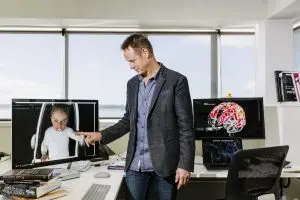
“When scientists see the world and artists see the world, they are looking at the same thing,” he says, “using a different language and viewpoint to describe it. But it’s all true. Everything is interconnected.”
This is a must read for anyone interested in the emerging developments of the leading edge of human-AI interfaces – and the future trajectory of AI.
The AI genius, who has built out his virtual BabyX from a laughing, crying head, sees a symbiotic relationship between humans and machines.
People get up to weird things in New Zealand. At the University of Auckland, if you want to run hours upon hours of experiments on a baby trapped in a high chair, that’s cool. You can even have a conversation with her surprisingly chatty disembodied head.
BabyX, the virtual creation of Mark Sagar and his researchers, looks impossibly real. The child, a 3D digital rendering based on images of Sagar’s daughter at 18 months, has rosy cheeks, warm eyes, a full head of blond hair, and a soft, sweet voice. When I visited the computer scientist’s lab last year, BabyX was stuck inside a computer but could still see me sitting in front of the screen with her “father.” To get her attention, we’d call out, “Hi, baby. Look at me, baby,” and wave our hands. When her gaze locked onto our faces, we’d hold up a book filled with words (such as “apple” or “ball”) and pictures (sheep, clocks), then ask BabyX to read the words and identify the objects. When she got an answer right, we praised her, and she smiled with confidence. When she got one wrong, chiding her would turn her teary and sullen.
If it sounds odd to encounter a virtual child that can read words from a book, it’s much more disorienting to feel a sense of fatherly pride after she nails a bunch in a row and lights up with what appears to be authentic joy. BabyX and I seemed to be having a moment, learning from each other while trading expressions and subtle cues so familiar to the human experience. That’s the feeling Sagar is after with his research and his new company Soul Machines Ltd.
Sagar is a leading figure in the camp trying to humanize AI, which he says has the potential to yield a more symbiotic relationship between humans and machines. While he wasn’t the first to this idea, his approach is unique, a synthesis of his early years as a computer scientist and later ones in the world of Hollywood special effects. The face, he’s concluded, is the key to barreling through the uncanny valley and making virtual beings feel truly lifelike. Soul Machines’ creations are unparalleled in this respect, able to wince and grin with musculature and features that move shockingly like ours. They have human voices, too, and are already contracted for use as online helpers for companies ranging from insurance providers to airlines. Soul Machines wants to produce the first wave of likable, believable virtual assistants that work as customer service agents and breathe life into hunks of plastic such as Amazon.com’s Echo and Google Inc.’s Home.
This is a long read – the entire article is here
Leave a Reply